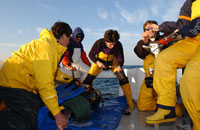Stanford marine biologist Barbara Block wins Rolex Award for Enterprise
BARBARA BLOCK, the Charles & Elizabeth Prothro Professor in Marine Sciences at at Stanford’s Hopkins Marine Station, has been awarded a Rolex Award for Enterprise for her plan to monitor large predators off the coast of California. The biennial awards “foster a spirit of enterprise and advance human knowledge and well-being.”
The award comes with a prize equivalent to approximately $104,000.
For more than two decades, Block has led a cadre of scientists from around the world in two large-scale tagging programs in the Atlantic and Pacific Oceans, monitoring a menagerie of marine animals, including bluefin tunas and white sharks, while serving as an advocate for ocean conservation.
Block and her colleagues have pioneered the use of electronic tags, including implantable archival tags, which are surgically implanted in tunas, and pop-up satellite archival tags, which automatically detach from animals and transmit collected data via satellite.
Building on the tags’ success, Block and collaborators also launched the Tagging of Pacific Predators(TOPP) program, now in its 12th year. The TOPP team deployed more than 4,600 electronic tags on a variety of species in the North Pacific and collected nearly 300,000 days of animal tracking data, revealing previously unknown marine hotspots, migratory highways and details of ocean physics.
One of TOPP’s most remarkable findings was that large predators from areas as diverse as the waters off New Zealand, Indonesia and Alaska congregate in the California Current – a productive, cold oceanic current that flows along North America’s west coast from Canada to Baja. Although they may make journeys of thousands of miles into the Pacific basin, they return to the California Current repeatedly, year after year. Block has labeled the almost pristine environment “a blue Serengeti.”
“It’s bursting with predators,” said Block, “and it’s right in our own backyard.”
With the Rolex Award, Block and the TOPP research team will be able to move forward with plans to protect and monitor these areas by building “predator cafés” – acoustic observatories of predator hotspots.
Rather than using satellite-based tags to follow these animals throughout their entire Pacific journeys, Block now hopes to use longer lasting and less expensive acoustic tags. A network of receivers that communicate with satellite and cell networks, both fixed at hotspots and attached to unmanned Wave Glider vehicles, will allow researchers to track predators this summer and fall in real time from Point Lobos to Tomales Point. She hopes to extend this ocean observing network down the west coast of North America.
Block’s team is also building a website and mobile app that will provide real-time updates on predator movements to the general public, using 12 years of tracking data to tell the animals’ full stories.
“We hope to connect the public to the predators,” said Block.
Ultimately, the goal of the monitoring project will be to increase protection for these rich predator regions. Block and her colleagues suggested designating the hotspot regions of the California Current a UNESCO World Heritage Site in a recent paper in the journal Nature.
“When large predators are being eliminated in other regions of the ocean, it’s important that we do all we can to protect and ensure the future of this remarkable ecosystem off our coast,” Block said. “Thus far, it’s remained stable despite exploitation and climate perturbations. Understanding why could teach us a lot about the ocean portion of this planet.”
— BY MAX MCCLURE




